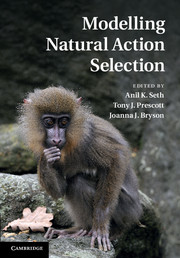Book contents
- Frontmatter
- Contents
- Foreword
- Preface
- Contributors
- 1 General introduction
- Part I Rational and optimal decision making
- 2 Introduction to Part I: rational and optimal decision making
- 3 Do we expect natural selection to produce rational behaviour?
- 4 Optimised agent-based modelling of action selection
- 5 Compromise strategies for action selection
- 6 Extending a biologically inspired model of choice: multi-alternatives, nonlinearity, and value-based multidimensional choice
- 7 Bayesian approaches to modelling action selection
- 8 Post-retrieval inhibition in sequential memory search1
- Part II Computational neuroscience models
- Part III Action selection in social contexts
- Index
- Plate section
- References
3 - Do we expect natural selection to produce rational behaviour?
from Part I - Rational and optimal decision making
Published online by Cambridge University Press: 05 November 2011
- Frontmatter
- Contents
- Foreword
- Preface
- Contributors
- 1 General introduction
- Part I Rational and optimal decision making
- 2 Introduction to Part I: rational and optimal decision making
- 3 Do we expect natural selection to produce rational behaviour?
- 4 Optimised agent-based modelling of action selection
- 5 Compromise strategies for action selection
- 6 Extending a biologically inspired model of choice: multi-alternatives, nonlinearity, and value-based multidimensional choice
- 7 Bayesian approaches to modelling action selection
- 8 Post-retrieval inhibition in sequential memory search1
- Part II Computational neuroscience models
- Part III Action selection in social contexts
- Index
- Plate section
- References
Summary
Summary
We expect that natural selection has resulted in behavioural rules that perform well, however, animals (including humans) sometimes make bad decisions. Researchers account for these with a variety of explanations; we concentrate on two of them. One is that the outcome is a side-effect; what matters is how a rule performs (in terms of reproductive success). Several rules may perform well in the environment in which they evolved, but their performance may differ in a ‘new’ environment (e.g., the lab). Some rules may perform very badly in this environment. We use the debate about whether animals follow the matching law rather than maximising their gains as an illustration. A second possibility is that we were wrong about what is optimal. The general idea here is that the setting in which optimal decisions are investigated is too simple and may not include elements that add extra degrees of freedom to the situation.
Introduction
The theme of this volume is modelling natural action selection. In this chapter we are concerned with modelling the action of natural selection. Selecting the best action when making a decision can be of great importance to an individual's fitness; we often term making the right choice as being ‘rational’. Ultimately, however, decision-making processes are products of an individual's evolutionary history, influenced to a greater or lesser degree by natural selection. Here we are concerned with whether we should expect ‘rational’ behaviour to be a product of naturally selected systems. In a general sense, rationality involves thinking and behaving reasonably and logically, but the term holds different meanings for researchers in different intellectual fields. The meaning and implications of the term ‘rationality’ have been discussed at great length. We do not intend to try to review all of these here, but use the categorisations of Kacelnik (2006) as a guide (for further introductions to the debate, see Manktelow and Over, 1993; Moser, 1990; Wilson, 1974). The general area of evolution and rationality is vast and our coverage is highly selective; many issues have not been considered. For other topics and perspectives, see Bernardo and Welch (2001), Bogacz et al. (this volume), Bateson and Healy (2005), Binmore (1997), Cooper (2001), Dickson (2006, 2008), Kirkpatrick et al. (2006), Nozick (1993), Pothos and Busemeyer (2009), Rieskamp et al. (2006), Robson (2002; 2003), Shafir and Le Boeuf (2002), Sober (1981), Stein (1996), and Waldman (1994).
- Type
- Chapter
- Information
- Modelling Natural Action Selection , pp. 12 - 36Publisher: Cambridge University PressPrint publication year: 2011
References
- 1
- Cited by



